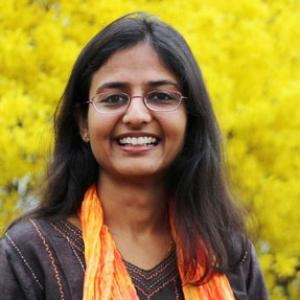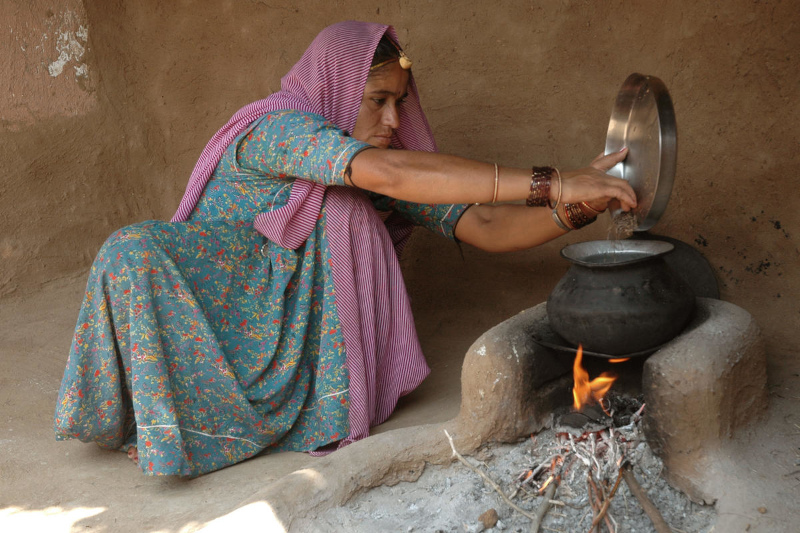A climate strategy for a growing nation
EDF senior scientist Kritee on efforts in India and how she stays hopeful in the face of challenges
EDF has been working with partners in India for nearly a decade to promote low-carbon rural development. The scale of the challenge is great, but so is the opportunity. If India is able to follow a climate-smart path to rural development, it can promise a better future not just for India’s farmers, but for the planet.

Our climate destiny is intertwined with how all underserved populations of the world, including in India, choose to get food, fuel and fiber.
Kritee, EDF's senior scientist leading research on climate-smart agriculture in India
We sat down with EDF climate scientist Kritee, to talk about her team’s work in India and how she stays motivated in the face of a sometimes daunting climate battle. In addition to her expertise in biogeochemistry, Kritee is a Zen priest and meditation teacher who brings a passion for justice and the wisdom of Zen to her climate work.
Q: Why did you become a scientist?
A: I have a curiosity about natural phenomena, about how life came to be, and I was always passionate about social justice. Just before I came to the U.S. to get my Ph.D., I spent a summer with my grandfather’s colleagues visiting villages in India. Seeing the poverty, the pollution, the people who felt voiceless — it pierced my heart. When I got to Rutgers to study bioinformatics, I became depressed. I wanted to do something as a scientist to make society more just. That’s how I eventually made my way into the climate field. Now I’m constantly at that interface of scientific research and environmental justice. That’s what keeps me excited about our work in India.
Q: How is climate change impacting India right now?
A: Climate change often exacerbates the extremes. Droughts are hotter and longer. In Delhi, extreme heat waves can make roads melt. And when rain does come, it’s not a gentle, sprinkling rain — what we call in Hindi rimjhim. It’s torrential burst of rain falling on hard, degraded soils or roads and buildings that can’t retain water. So, we see flooding and immense devastation. In July 2020, the city of Mumbai, which has 24 million people, got more than 39 inches of rain in three days. That’s what most U.S. cities get in an entire year.
Q: Why is EDF working in rural India?
A: The developing world is a vital partner in solving climate change. Most of India hasn’t been built yet, so when floods or droughts occur, the rural population is affected the most. Our job is to reimagine how to bring energy and food security to these households while helping the local economy to thrive.
Farmers in India are buried under debt. They can’t get credit. They don’t have money to invest in something like a new irrigation system. They often have to travel a long way to buy seeds or sell their produce, and often the seeds don’t grow, or crops go to waste because there is no cold storage.
We are working with partners on the ground to offer solutions that will help farmers become more profitable while also reducing their environmental impacts — like using water and fertilizer more efficiently; and by introducing highly efficient cookstoves instead of smoky wood-burning stoves.

One of my favorite moments was with a woman whose wood-fired cooking at home was replaced by a biogas cookstove. She was beaming and so proud to tell me that her face and hands no longer became black from soot that comes from burning wood. She was pointing to all the walls of her house and saying, “See, see, these walls don’t get black now!”
Learn more about our work in India
Q: How do you talk to farmers in India about shifting their agricultural practices?
A: No matter where you are in the world, you can’t walk up to a farmer and tell them, “Here’s how you should grow your food so you can reduce climate pollution.” If we want them to accept our advice, we have to first build trust.
When you offer a whole system that helps, then people are willing to listen to your recommendations. We call it the triple bottom line: higher yields, higher profits and climate benefits. Now the state and national governments are taking notice and want to work with us.
Q: So, what kinds of solutions have we been able to offer farmers?
A: In Bihar, a state of more than 100 million people, we partnered with research institutions and the government to build a support network to help 15,000 small farmers produce more food, more profitably — while reducing climate pollution. We partner with microentrepreneurs that provide farmers with access to high-quality seeds and a link to more profitable markets to sell the food they grow. We help with things like crop insurance and credit lines; or helping a community to get a bank loan that a single farmer would not be able to get.
We also built an app and toll-free number, to give farmers customized guidance on their fertilizer, irrigation and pest control. On average, farmers who use the app are increasing their profits by 5% to 10%, because they’re able to grow 10% to 20% more food — while using less fertilizer and less energy to pump water.
Q: Your team also made a groundbreaking discovery about rice farming that rippled globally.
A: Rice is the single most important crop for the poor in Asia and Africa. It uses more land, water and chemicals for rice than any other crop, and it produces a great deal of methane. So, my team was studying the climate impacts of different rice farming techniques. I expected we would see changes in methane, but instead my team found extremely high amounts of nitrous oxide, which is a much more powerful greenhouse gas than methane.
I thought, “Are our instruments not working?” But after five years of measurements and modeling, we realized we had discovered a big nitrous oxide problem: the climate impact of rice farms could potentially be equal to the global impact of methane from oil and gas. And the current recommendations to reduce methane from rice farming might cause more harm than good by increasing nitrous oxide.
Q: And did the results change farming practices?
A: In the case of rice, we were able to find an elegant solution. We knew that when farmers use a moderate level of water to flood their fields, and do it at specific times, they can decrease their climate impact up to 60%. So, we were able to incentivize farmers to monitor and manage their water supply by giving them a comprehensive program to increase crop yields and profits while using less water.
Q: What makes you feel optimistic about working in India?
A: We gained trust by giving farmers solutions they really needed, what they were hungry for. It helps that our work aligns well with government priorities, and they are keen to test new ideas. Finding scalable solutions is half the battle.
But at the most basic level, farmer satisfaction and our ability to gain their trust — that’s huge. Because farmers talk to each other. These communities are strong. They are the ones moving this work forward.
Q: You go by one name, Kritee. Can you explain the significance of that?
A: It goes back to feminism. My mom didn’t change her last name after she got married, and when I was born, she only put my first name on my birth certificate. She said, “My daughter will decide what she wants to pick as her last name.” I went by one name all my life, but when I came to the United States the computer systems couldn’t handle it! They refused to give me a visa with just a first name, so they made Kritee my last name and put the letters FNU — first name unknown — for my first name. So for the first few years my name was Fnu Kritee.
Q: You’re also Zen Buddhist priest. How does that help your work as a climate scientist?
A: To be in this field, it’s not enough to use your intellect alone. You need to bring your heart, spirit and intellect together. If I didn’t meditate and work on my psychological and spiritual health, I would be paralyzed! That inner work is the backbone of the other two wings of my life, climate and justice. That’s how I’m able to keep flying.
Q: What advice do you have for people struggling with climate anxiety?
A: The most important thing is friendship and community. Feeling alone is frustrating. You get angry, and that leads to denial. I want to distract myself so I’ll binge-watch Netflix, right? If we want to take courageous action and build the kind of world we want to build, we have to come together as communities that do the psychological and spiritual work and the policy and advocacy work together.
Also, pay attention to how you feel. I always say that emotion is e-motion, it gets us to move. Don’t suppress what you feel, because underneath that grief is love. And if we can touch that love with the help of our community, it will power our climate and social justice movements.
Published: March 21, 2022










